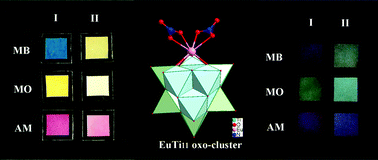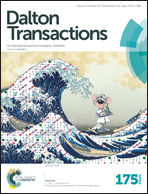A lanthanide–titanium (LnTi11) oxo-cluster, a potential molecule based fluorescent labelling agent and photocatalyst†
Abstract
Although a lot of titanium oxo-clusters (TOCs) have been synthesized and characterized, research studies on their application properties are still limited. The work described here is not only aimed at the synthesis and crystal structures of the TOCs, but also aimed at exploration of their potential applications in molecule based fluorescence labelling and photocatalysis. Three heterometallic TOC compounds with lanthanide (Ln) elements Sm(III) (1), Eu(III) (2) and Gd(III) (3) are prepared and their cluster structures are characterized as LnTi11 cages. Compound 2 exhibits the characteristic fluorescence of Eu(III) and the emission intensity can be decreased upon irradiation and recovered by air oxidation, which is attributed to the energy transfer between Eu(III) and photo-induced Ti(III) of the oxo-TiO cluster. The fluorescence intensity of 2 can be significantly increased when treated with 1,10-phenanthroline. The catalytic properties of 2 were determined by the degradation of dyes on a paper substrate. Compound 2 has potential applications as a molecule based fluorescent labelling agent and photodegeneration catalyst.


 Please wait while we load your content...
Please wait while we load your content...